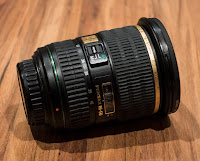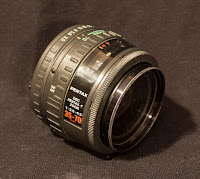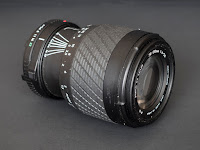This lens came free to me as it was purchased by my wife several years ago for her Pentax K20D. As she has moved on to Nikon (D800), it is now part of my lens collection.
I can immediately state that this lens will be part of my standard lens kit for when I'm travelling. The excellent sharpness, nice colors and fast aperture makes this a great lens. Additionally, it is weather proof, so ready for use in any condition. But, perhaps most important, as it is an APS-C lens, the focal range is true to my camera (no conversion factor), making this a great lens for large buildings and landscapes.
The lens can be switched from auto to manual, but on my camera (Sony a6000), it is of course always manual as there is no mount adapter available to pass on any aperture, focal or focus information. So neither the screw drive focus as the internal focus motor will work.
This lens is known to fail the SDM motor after a short while and that was indeed the case with this lens. My Pentax K10D is still able to use the body screw drive focus, but on my wife's K20D that only supports SDM for this lens, it stopped working completely.
For an expensive lens, it lacks a stabilization system, as Pentax only support in-body stabilization. As this is not available on my Sony, the high ISO capabilities were really useful for this night time shoot in Chicago.
Zoom and focus rings are smooth, but not as smooth as on the older Pentax A or M lenses, Very easy to manually focus due to the wide focus ring.
For sure, I plant to test this lens again in the summer, under daylight conditions...
Some DA* lenses, such as the DA* 16-50 were co-developed with Tokina.
To combat partial reflection, Pentax developed chemical coatings for the lens surfaces with minimum light loss. SMC is "a remarkable seven-layer lens coating process that cuts the reflection ratio down to just 0.2% per lens surface. The result is a dramatic improvement in both color fidelity and brightness and the elimination of flare and ghost images."
SMC was patented and first applied in 1971, when Pentax was still making screw mount equipment. The multi-coated lens lines changed from Takumar and Super-Takumar to Super-Multi-Coated Takumar and later on to SMC Takumar. SMC Pentax was used for the newly introduced K-mount lenses. Pentax's SMC is still today considered as one of the best lens coatings on the market.
The SDM mechanism is claimed to provide smoother and quieter focusing.
(ED), Pentax lens featuring an extra-low dispersion glass to reduce color aberrations
AL or Aspherical lenses which indicates it has at least one aspherical element in it to improve corner sharpness, especially in wide and ultra wide angle lenses
[IF], or internal focus system which means the lens doesn't get longer or shorter as it focuses. This can be important on large lenses because and external focusing lens can shift balance of the camera dramatically.
Focal Length: 16-50mm
Maximum Aperture: F2.8
Minimum Aperture: F22
Image Format: APS-C
Lens Mount: Pentax KAF2
Optics: 15 elements, 12 groups
Blades: 9 blades
Focussing: AF (in lens motor or screwdrive), SDM
Minimum Focus: 30cm
Maximum Magnification: 0.21x
Filter Size: 77mm
Weight: 565g
Length: 98.5mm
Production: 2007 to present
Serial Number: 9012788
Samples:
 |
| 1/50 sec - ISO1600 |
 |
| 1/60 sec - ISO1600 |
 |
| 1/80 sec - ISO1600 |
 |
| 1/100 sec - ISO1600 |
 |
| 1/50 sec - ISO1600 |
 |
| 1/60 sec - ISO1600 |
 |
| 1/80 sec - ISO1600 |
Sources:
Wikipedia - Pentax
Wikipedia Pentax (Lens)
Pentax Forums
All Photo Lenses














































